八年级英语下册阅读理解知识点(大全)经典1
八年级英语下册阅读理解知识点总结

八年级英语下册阅读理解知识点总结一、八年级英语下册阅读理解专项练习(含答案解析)1.阅读理解More than fifty years ago, Barbie Millicent Roberts first appeared in the world of toys. Since then, Barbie doll, as everyone called her, has become the most successful toy doll in history. Her parent, the Mattel Company, said that 90G of all American girls between 3 and 10 have at least one Barbie at home.However, Barbie is facing some trouble at present. There are many similar dolls on the market in competition with her. Another doll named Bratz, for example, came to life about sixteen years ago. She looks more like today's pop stars with heavy makeup(浓妆) and miniskirts. And her company offers more kinds of clothes.It seems that Barbie has lost her magic among older girls. "For younger girls, playing with a Barbie is much funnier. But when you get older, you want something smarter and more modern," says Vera Shepherd, a shop assistant of a toy store in New York.It is good news that on the international market, Barbie is still No. 1. Although Mattel is selling fewer Barbies in the United States these years, sales in other countries are still going up. Mattel opened its first Barbie store in Shanghai, where girls can shop, eat, drink or even become fashion designers for their own Barbies.Mattel is planning big celebrations for Barbie's 58th birthday. Fashion designers from all over the world have been called to make new dresses for Barbie. How long will Barbie stay popular in the world of toy dolls? It is hard to say, but 58 is surely not the age to retire(退休).(1)Barbie's family name is .A. RobertsB. MillicentC. ShepherdD. Bratz(2)Barbie's trouble is that .A. she wears heavy makeup and miniskirtsB. other dolls are more popular with little girlsC. other dolls are trying to beat her in the marketD. she has become less popular in the international market(3)Girls can do the following in the first Barbie store in Shanghai EXCEPT .A. going shoppingB. having foodC. drinking juiceD. taking photos(4)What's the meaning of the underlined words "fashion designers" in the passage? A. 珠宝设计师 B. 发型设计师 C. 舞台设计师 D. 时装设计师【答案】(1)A(2)C(3)D(4)D【解析】【分析】本文主要介绍了芭比娃娃的起源,以及现在的发展状况。
最新八年级英语下册任务型阅读专题(含答案)经典

最新八年级英语下册任务型阅读专题(含答案)经典一、八年级英语下册任务型阅读专项练习(含答案解析)1.任务型阅读People usually hate mice, but one mouse wins the hearts of the people all over the world—the famous Mickey Mouse.Fifty years ago, most films had no sounds. A man named Walt Disney made a cartoon mouse that could talk in these films. He named his mouse Mickey Mouse. Soon Mickey Mouse became a good friend of both young and old people. Children like to see their lovely friend, because he brought happiness to them.Mickey is a clean mouse right from the beginning. Perhaps this is why people love Mickey Mouse. In his early life Mickey made some mistakes. People were very angry. They wrote to Disney and said that they didn't want Mickey to do wrong things. As there were many things that Mickey could not do, Disney made a new animal named Donald Duck. He also made a dog, Pluto. This dog does foolish things and makes mistakes wherever he goes. Now our Mickey Mouse is not only clean, but more interesting. He came out as a star of beauty and wisdom (智慧). He has his friends in almost every country.(1)Why do people like Mickey Mouse?(不超过10个词)(2)What did Disney make besides Mickey?(不超过5个词)(3)Why did Disney make Donald Duck?(不超过15个词)【答案】(1)Because he brought happiness to people.(2)Donald Duck and Pluto.(3)Because there were many things that Mickey could not do.【解析】【分析】短文大意:这篇短文讲的是电影米老鼠和唐老鸭的制作过程。
2020-2021年八年级英语下册阅读理解点+例题_全面解析(word)1
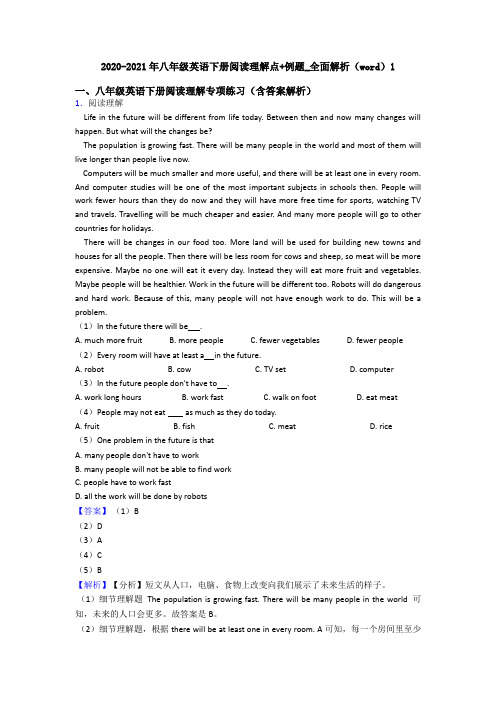
2020-2021年八年级英语下册阅读理解点+例题_全面解析(word)1一、八年级英语下册阅读理解专项练习(含答案解析)1.阅读理解Life in the future will be different from life today. Between then and now many changes will happen. But what will the changes be?The population is growing fast. There will be many people in the world and most of them will live longer than people live now.Computers will be much smaller and more useful, and there will be at least one in every room. And computer studies will be one of the most important subjects in schools then. People will work fewer hours than they do now and they will have more free time for sports, watching TV and travels. Travelling will be much cheaper and easier. And many more people will go to other countries for holidays.There will be changes in our food too. More land will be used for building new towns and houses for all the people. Then there will be less room for cows and sheep, so meat will be more expensive. Maybe no one will eat it every day. Instead they will eat more fruit and vegetables. Maybe people will be healthier. Work in the future will be different too. Robots will do dangerous and hard work. Because of this, many people will not have enough work to do. This will be a problem.(1)In the future there will be .A. much more fruitB. more peopleC. fewer vegetablesD. fewer people (2)Every room will have at least a in the future.A. robotB. cowC. TV setD. computer(3)In the future people don't have to .A. work long hoursB. work fastC. walk on footD. eat meat(4)People may not eat as much as they do today.A. fruitB. fishC. meatD. rice(5)One problem in the future is thatA. many people don't have to workB. many people will not be able to find workC. people have to work fastD. all the work will be done by robots【答案】(1)B(2)D(3)A(4)C(5)B【解析】【分析】短文从人口,电脑、食物上改变向我们展示了未来生活的样子。
英语八年级英语下册阅读理解及答案

英语八年级英语下册阅读理解及答案一、八年级英语下册阅读理解专项练习(含答案解析)1.阅读理解More than fifty years ago, Barbie Millicent Roberts first appeared in the world of toys. Since then, Barbie doll, as everyone called her, has become the most successful toy doll in history. Her parent, the Mattel Company, said that 90G of all American girls between 3 and 10 have at least one Barbie at home.However, Barbie is facing some trouble at present. There are many similar dolls on the market in competition with her. Another doll named Bratz, for example, came to life about sixteen years ago. She looks more like today's pop stars with heavy makeup(浓妆) and miniskirts. And her company offers more kinds of clothes.It seems that Barbie has lost her magic among older girls. "For younger girls, playing with a Barbie is much funnier. But when you get older, you want something smarter and more modern," says Vera Shepherd, a shop assistant of a toy store in New York.It is good news that on the international market, Barbie is still No. 1. Although Mattel is selling fewer Barbies in the United States these years, sales in other countries are still going up. Mattel opened its first Barbie store in Shanghai, where girls can shop, eat, drink or even become fashion designers for their own Barbies.Mattel is planning big celebrations for Barbie's 58th birthday. Fashion designers from all over the world have been called to make new dresses for Barbie. How long will Barbie stay popular in the world of toy dolls? It is hard to say, but 58 is surely not the age to retire(退休).(1)Barbie's family name is .A. RobertsB. MillicentC. ShepherdD. Bratz(2)Barbie's trouble is that .A. she wears heavy makeup and miniskirtsB. other dolls are more popular with little girlsC. other dolls are trying to beat her in the marketD. she has become less popular in the international market(3)Girls can do the following in the first Barbie store in Shanghai EXCEPT .A. going shoppingB. having foodC. drinking juiceD. taking photos(4)What's the meaning of the underlined words "fashion designers" in the passage? A. 珠宝设计师 B. 发型设计师 C. 舞台设计师 D. 时装设计师【答案】(1)A(2)C(3)D(4)D【解析】【分析】本文主要介绍了芭比娃娃的起源,以及现在的发展状况。
最新八年级英语下册阅读理解知识点梳理及经典练习(超详细)(word)1

最新八年级英语下册阅读理解知识点梳理及经典练习(超详细)(word)1一、八年级英语下册阅读理解专项练习(含答案解析)1.阅读理解Sydney Fredette is very busy. Not only is she a high school student, but she has also set up her own organization(组织), Beary Merry Christmas. She volunteers(志愿) to offer services to poor children and families in Orange Country in California, US.To remember her best friend who died of cancer nearly 10 years ago, Fredette decided to offer services to those in Orange Country who are less lucky than she is.She began with the easy idea of collecting donated(捐赠)Build-A-Bears, the popular toy animal that is made by children themselves in the stores' workshops. Fredette then gave them as presents to the homeless children in California during the holiday season.With donations at more than 100 bears a year, Fredette and volunteers hold activities every year, where volunteers not only give out the bears, but also clothing, meals, and other things.Not wanting to limit(限制)the giving to just the holiday months, Fredette held other activities for Valentine's Day, Mother's Day and Halloween, offering the chance to her volunteer team to make a difference through the year."I love making friends with the people I offer services to," Fredette said. "It's so cool to hear their stories and see how happy they are."Fredette even built a public food bank and offered a self-development class to students in her school.She plans to stay local and continue to help out in her hometown.(1)Which statement is Not True about Beary Merry Christmas?A. It was set up by Sydney FredetteB. It gives out bears and other thingsC. It offers services around America.D. It holds many activities every year.(2)What can be the best title for the passage?A. A public food bankB. A self-development classC. Fredette and Beary Merry ChristmasD. Build-A-Bear(3)In which part of a newspaper can we probably find the reading?A. SportsB. NewsC. ArtD. Science【答案】(1)C(2)C(3)B【解析】【分析】文章大意:介绍了Fredette创办了一个组织,他们经常在节日里为无家可归的孩子提供服务,最后引述了这个主人公的言论。
【英语】 八年级英语下册任务型阅读测试题(A)﹙含答案﹚经典1

【英语】八年级英语下册任务型阅读测试题(A)﹙含答案﹚经典1一、八年级英语下册任务型阅读专项练习(含答案解析)1.任务型阅读CThere was a park near my home,but I didn't go there often.Many people said there was nothing special there.One afternoon l went into the park.I walked quickly because there wasn't much to see.________"Which way should I go?"I asked myself.I looked at one path (小路),then the other.I found that the two paths were different from each other.The left one was wide and clean.________ Although me flowers weren't very beautiful.they made me feel good.I decided to take this path.But wait!I looked at the right one.The path didn't look nice.It looked like it had not been cleaned for months.For a long time I couldn't decide which path to choose.________It wasn't nice,but I didn't want to give up(放弃).At last,I came to the end of the path.Ah!There was a small garden there.It was beautiful.There were trees,flowers and chairs there.I thought it was the nicest part of the park.Many people told me that there was nothing much to see in the park .Now I'd like to tell them that if they had followed the right way ,they would have felt differently.________I knew they didn't believe me.They couldn't even remember that-path because it was so small.My trip to the park made me understand something about life.________You may get a big surprise!根据材料内容从方框中选择合适的句子填入文中空缺处,使材料内容完整、通顺,其中有一个句子是多余的。
【英语】八年级英语下册阅读理解真题 经典1
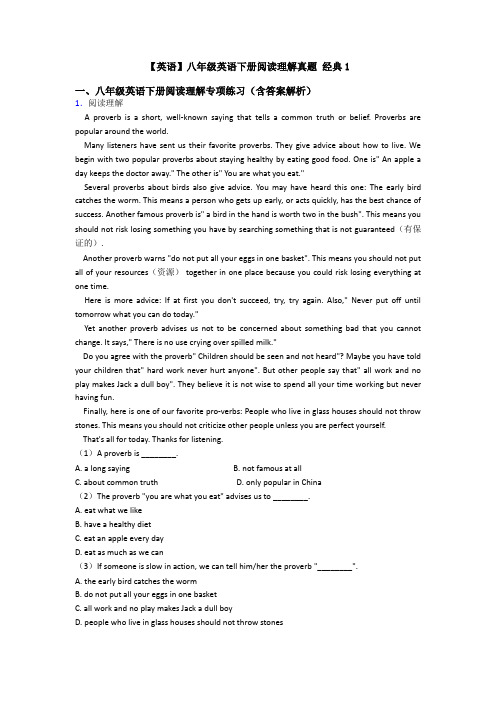
【英语】八年级英语下册阅读理解真题经典1一、八年级英语下册阅读理解专项练习(含答案解析)1.阅读理解A proverb is a short, well-known saying that tells a common truth or belief. Proverbs are popular around the world.Many listeners have sent us their favorite proverbs. They give advice about how to live. We begin with two popular proverbs about staying healthy by eating good food. One is" An apple a day keeps the doctor away." The other is" You are what you eat."Several proverbs about birds also give advice. You may have heard this one: The early bird catches the worm. This means a person who gets up early, or acts quickly, has the best chance of success. Another famous proverb is" a bird in the hand is worth two in the bush". This means you should not risk losing something you have by searching something that is not guaranteed(有保证的).Another proverb warns "do not put all your eggs in one basket". This means you should not put all of your resources(资源) together in one place because you could risk losing everything at one time.Here is more advice: If at first you don't succeed, try, try again. Also," Never put off until tomorrow what you can do today."Yet another proverb advises us not to be concerned about something bad that you cannot change. It says," There is no use crying over spilled milk."Do you agree with the proverb" Children should be seen and not heard"? Maybe you have told your children that" hard work never hurt anyone". But other people say that" all work and no play makes Jack a dull boy". They believe it is not wise to spend all your time working but never having fun.Finally, here is one of our favorite pro-verbs: People who live in glass houses should not throw stones. This means you should not criticize other people unless you are perfect yourself.That's all for today. Thanks for listening.(1)A proverb is ________.A. a long sayingB. not famous at allC. about common truthD. only popular in China(2)The proverb "you are what you eat" advises us to ________.A. eat what we likeB. have a healthy dietC. eat an apple every dayD. eat as much as we can(3)If someone is slow in action, we can tell him/her the proverb "________".A. the early bird catches the wormB. do not put all your eggs in one basketC. all work and no play makes Jack a dull boyD. people who live in glass houses should not throw stones(4)What is this passage probably used for?A. An English textbook.B. An English TV program.C. An English speech contest.D. An English radio program.【答案】(1)C(2)B(3)A(4)D【解析】【分析】文章大意:谚语在世界范围内受欢迎,接着说了一些谚语的意义,举出了具体的谚语和意义。
2020-2021年八年级英语下册阅读理解 复习1

2020-2021年八年级英语下册阅读理解复习1一、八年级英语下册阅读理解专项练习(含答案解析)1.阅读理解Let's enjoy a movie!ZootopiaFrom a large elephant to a small mouse, animals live happily together inDisney's Zootopia.Language : EnglishRunning Time: 1 Hour and 49 MinutesPrice: Weekdays— $ 50$ 25 (children under 6)Weekends—$ 60$ 30 (children under 6)I've never imagined the movie is so interesting. There are many kinds of animals in it. After I watched the movie, I learned more about animals. I would highly recommend this movie to those animal lovers.—John I have seen many cartoons of this kind, but this one is surprisingly funny and I love the sweet voice in it. My brother and I just couldn't help laughing from the beginning to the end.—David This movie is so well made I went to see it with my 5-year-old son last Sunday afternoon. I love the beautiful music while my son loves the rabbit police officer Judy very much. It shows that small animals like her can also do serious work.—Nancy (1)The poster shows that is spoken in the movie.A. JapaneseB. FrenchC. EnglishD. Chinese(2)From the poster, we can know that the movie lasts .A. 60 minutesB. 109 minutesC. 99 minutesD. 120 minutes (3)John likes this movie because of .A. the different kinds of animalsB. the funny actorsC. the sweet voiceD. the beautiful music(4)It cost Nancy and her son to watch the movie.A. $75B. $90C. $100D. $120【答案】(1)C(2)B(3)A(4)B【解析】【分析】本文主要介绍了一部电影的基本信息以及人们对这部电影的评价。
2020-2021年人教版英语八年级英语下册阅读理解(word)1

2020-2021年人教版英语八年级英语下册阅读理解(word)1一、八年级英语下册阅读理解专项练习(含答案解析)1.阅读理解DDear Mum,You think you know a lot of things about me, but you don't. You try to tell me how to dress, but you don't realize that it should be my decision.I don't think that you have any respect (尊重) for me, because you come into my room, touch anything you want, and don't even put things back in their place. Could you please change a little?Sincerely,Your son JohnDear Mum,My life is different from yours because we grew up in different times. I have to go out into the world and experience it myself! But don't worry about me, because I come from a happy family. I'm still your little girl, but I'll be an adult some day. I want to be the best and strongest me. You taught me about it. Thanks Mum!Sincerely,Your daughter HelenDear Mum and Dad,I'm writing you this letter because I need to tell you both something. I want to continue my education at a college in our city. I want to go to school part-time and work part-time.Now I'm 17 years old. I need to make decisions on my own. I need a goal and a plan for my future. You've taught me to be strong and do what I believe in. I want to say thanks for everything you did for me.Love,Your son Mike(1)Why doesn't John think his mother respects him?A. Because she never says “please” to John.B. Because she always asks John to do what she likes.C. Because she never asks John's opinions about anything.D. Because she always touches John's things without putting them back.(2)What may be the problem between Helen and her mother?A. Her mother is too strict with herB. She can't understand her mother.C. Her mother worries too much about her.D. She is too young to look after her mother.(3)Helen wants to say ________ to her mother.A. sorryB. thanksC. goodbyeD. welcome(4)Mike writes to his parents to ________.A. share with them his life in schoolB. tell them how much he loves themC. tell them his ideas about his futureD. tell them about his favourite college(5)Which of the following is TRUE according to the last letter?A. Mike will go to college when he is 17 years old.B. Mike wants to go to a college far from his home.C. Mike is thankful for everything his parents did for him.D. Mike hopes to go to school full-time and work part-time【答案】(1)D(2)C(3)B(4)C(5)C【解析】【分析】文章大意:文章写了John,Helen和Mike写给父母的信。
最新英语八年级英语下册阅读理解及答案经典

最新英语八年级英语下册阅读理解及答案经典一、八年级英语下册阅读理解专项练习(含答案解析)1.语法填空China has a very long history. It has many great traditional skills that have a wide influence(影响). Here we mainly talk about kites.The earliest mention of a kite in ancient China dates back to the 5th century BC. It was made of wood and used as a rescue signal(求救信号).At the time between 770 and 221 BC, Chinese kites were actually called "muyuan". They were first invented in Shandong Province for military purposes(军事目的). The kites were used to send important messages during the Chu-Han War(206—202 BC). During the Tang Dynasty (618—907 AD), kites were made of lighter materials, such as bamboo, silk and paper. At that time, people began to fly kites for other purposes. It was believed that letting go of the kite could remove bad luck and illness.Today, kite-flying is an interesting and healthy activity in China. There are large kite-flying festivals held throughout the country, and kite makers can show off their skills during the festivals.(1)A kite was first mentioned in ancient China .A. in the 5th century BCB. two thousand years agoC. one thousand years agoD. in the 4th century BC(2)Between 770 and 221 BC, .A. kites had a wide influenceB. kites were used as a rescue signalC. kites were used to send family lettersD. kites were invented for military purposes(3)What does the last paragraph mainly talk about?A. Kite-flying is very popular in China today.B. Kite-flying is a good way to show off skills.C. Kite-flying has a very long history.D. Kite-flying can help people keep fit.(4)According to the passage, we can say that .A. it is very easy to fly a kiteB. in order to have good luck, we must fly a kiteC. kites have become lighter since the Tang DynastyD. in order to keep healthy, we must fly a kite every day【答案】(1)A(2)D(3)A(4)C【解析】【分析】本文主要讲述了风筝在中国从古至今的发展过程。
八年级英语下册阅读理解专题(含答案)
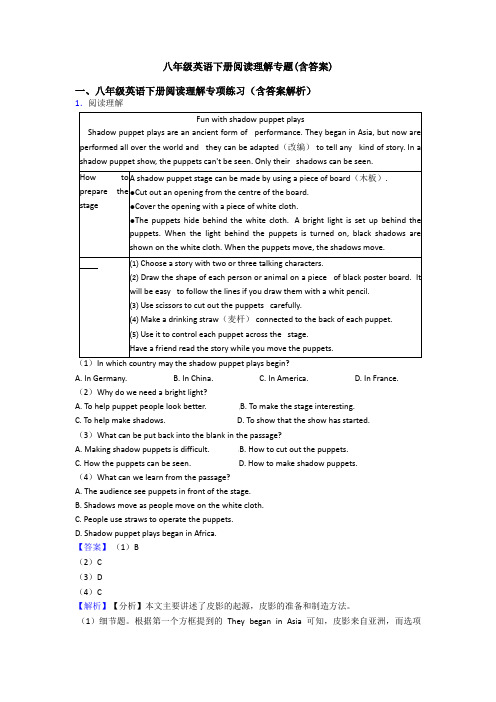
八年级英语下册阅读理解专题(含答案)一、八年级英语下册阅读理解专项练习(含答案解析) 1.阅读理解Fun with shadow puppet playsShadow puppet plays are an ancient form of performance. They began in Asia, but now are performed all over the world and they can be adapted (改编) to tell any kind of story. In a shadow puppet show, the puppets can't be seen. Only their shadows can be seen.How to prepare the stage A shadow puppet stage can be made by using a piece of board (木板). ●Cut out an opening from the centre of the board.●Cover the opening w ith a piece of white cloth.●The puppets hide behind the white cloth. A bright light is set up behind thepuppets. When the light behind the puppets is turned on, black shadows areshown on the white cloth. When the puppets move, the shadows move.⑴ Choose a story with two or three talking characters.⑵ Draw the shape of each person or animal on a piece of black poster board. Itwill be easy to follow the lines if you draw them with a whit pencil.⑶ Use scissors to cut out the puppets carefully.⑷ Make a drinking straw (麦杆) connected to the back of each puppet.⑸ Use it to control each puppet across the stage.Have a friend read the story while you move the puppets.(1)In which country may the shadow puppet plays begin?A. In Germany.B. In China.C. In America.D. In France.(2)Why do we need a bright light?A. To help puppet people look better.B. To make the stage interesting.C. To help make shadows.D. To show that the show has started.(3)What can be put back into the blank in the passage?A. Making shadow puppets is difficult.B. How to cut out the puppets.C. How the puppets can be seen.D. How to make shadow puppets.(4)What can we learn from the passage?A. The audience see puppets in front of the stage.B. Shadows move as people move on the white cloth.C. People use straws to operate the puppets.D. Shadow puppet plays began in Africa.【答案】 (1)B(2)C(3)D(4)C【解析】【分析】本文主要讲述了皮影的起源,皮影的准备和制造方法。
牛津译林版八年级下册英语Unit 1 Reading重点知识及练习- (含答案)
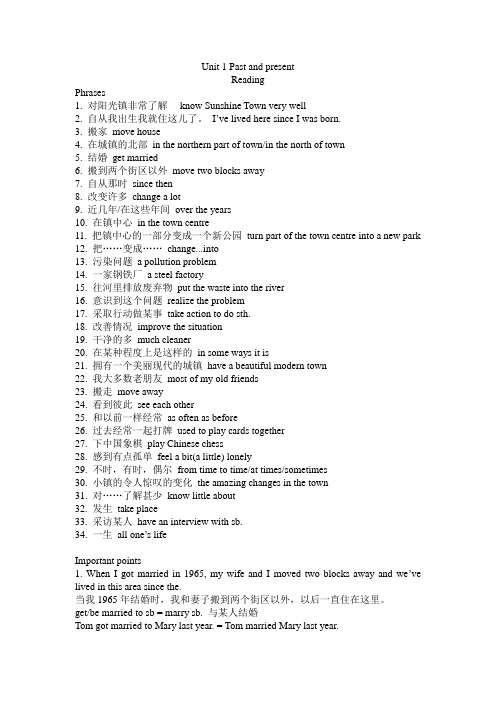
Unit 1 Past and presentReadingPhrases1. 对阳光镇非常了解know Sunshine Town very well2. 自从我出生我就住这儿了。
I’ve lived here since I was born.3. 搬家move house4. 在城镇的北部in the northern part of town/in the north of town5. 结婚get married6. 搬到两个街区以外move two blocks away7. 自从那时since then8. 改变许多change a lot9. 近几年/在这些年间over the years10. 在镇中心in the town centre11. 把镇中心的一部分变成一个新公园turn part of the town centre into a new park12. 把……变成……change...into13. 污染问题a pollution problem14. 一家钢铁厂a steel factory15. 往河里排放废弃物put the waste into the river16. 意识到这个问题realize the problem17. 采取行动做某事take action to do sth.18. 改善情况improve the situation19. 干净的多much cleaner20. 在某种程度上是这样的in some ways it is21. 拥有一个美丽现代的城镇have a beautiful modern town22. 我大多数老朋友most of my old friends23. 搬走move away24. 看到彼此see each other25. 和以前一样经常as often as before26. 过去经常一起打牌used to play cards together27. 下中国象棋play Chinese chess28. 感到有点孤单feel a bit(a little) lonely29. 不时,有时,偶尔from time to time/at times/sometimes30. 小镇的令人惊叹的变化the amazing changes in the town31. 对……了解甚少know little about32. 发生take place33. 采访某人have an interview with sb.34. 一生all one’s lifeImportant points1. When I got married in 1965, my wife and I moved two blocks away and we’ve lived in this area since the.当我1965年结婚时,我和妻子搬到两个街区以外,以后一直住在这里。
八年级英语下册阅读理解专题(含答案)

八年级英语下册阅读理解专题(含答案)一、八年级英语下册阅读理解专项练习(含答案解析) 1.阅读理解Fun with shadow puppet playsShadow puppet plays are an ancient form of performance. They began in Asia, but now are performed all over the world and they can be adapted (改编) to tell any kind of story. In a shadow puppet show, the puppets can't be seen. Only their shadows can be seen.How to prepare the stage A shadow puppet stage can be made by using a piece of board (木板). ●Cut out an opening from the centre of the board.●Cover the opening w ith a piece of white cloth.●The puppets hide behind the white cloth. A bright light is set up behind thepuppets. When the light behind the puppets is turned on, black shadows areshown on the white cloth. When the puppets move, the shadows move.⑴ Choose a story with two or three talking characters.⑵ Draw the shape of each person or animal on a piece of black poster board. Itwill be easy to follow the lines if you draw them with a whit pencil.⑶ Use scissors to cut out the puppets carefully.⑷ Make a drinking straw (麦杆) connected to the back of each puppet.⑸ Use it to control each puppet across the stage.Have a friend read the story while you move the puppets.(1)In which country may the shadow puppet plays begin?A. In Germany.B. In China.C. In America.D. In France.(2)Why do we need a bright light?A. To help puppet people look better.B. To make the stage interesting.C. To help make shadows.D. To show that the show has started.(3)What can be put back into the blank in the passage?A. Making shadow puppets is difficult.B. How to cut out the puppets.C. How the puppets can be seen.D. How to make shadow puppets.(4)What can we learn from the passage?A. The audience see puppets in front of the stage.B. Shadows move as people move on the white cloth.C. People use straws to operate the puppets.D. Shadow puppet plays began in Africa.【答案】 (1)B(2)C(3)D(4)C【解析】【分析】本文主要讲述了皮影的起源,皮影的准备和制造方法。
【英语】八年级英语下册阅读理解知识点梳理及经典练习(超详细)(word)
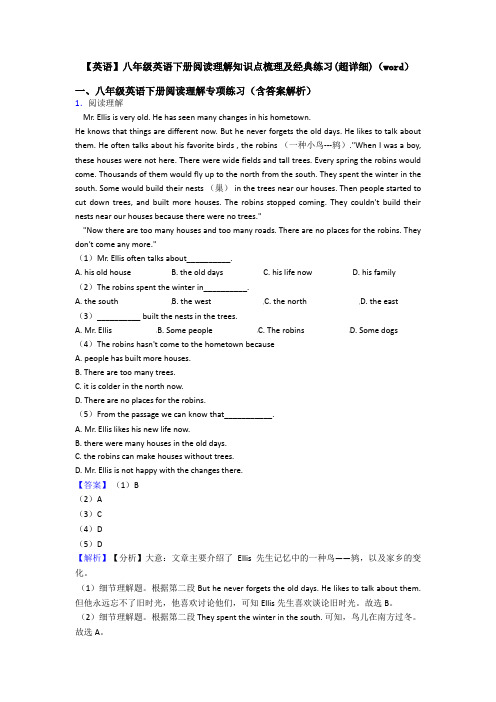
【英语】八年级英语下册阅读理解知识点梳理及经典练习(超详细)(word)一、八年级英语下册阅读理解专项练习(含答案解析)1.阅读理解Mr. Ellis is very old. He has seen many changes in his hometown.He knows that things are different now. But he never forgets the old days. He likes to talk about them. He often talks about his favorite birds , the robins (一种小鸟---鸫)."When I was a boy, these houses were not here. There were wide fields and tall trees. Every spring the robins would come. Thousands of them would fly up to the north from the south. They spent the winter in the south. Some would build their nests (巢) in the trees near our houses. Then people started to cut down trees, and built more houses. The robins stopped coming. They couldn't build their nests near our houses because there were no trees.""Now there are too many houses and too many roads. There are no places for the robins. They don't come any more."(1)Mr. Ellis often talks about__________.A. his old houseB. the old daysC. his life nowD. his family(2)The robins spent the winter in__________.A. the southB. the westC. the northD. the east(3)__________ built the nests in the trees.A. Mr. EllisB. Some peopleC. The robinsD. Some dogs(4)The robins hasn't come to the hometown becauseA. people has built more houses.B. There are too many trees.C. it is colder in the north now.D. There are no places for the robins.(5)From the passage we can know that___________.A. Mr. Ellis likes his new life now.B. there were many houses in the old days.C. the robins can make houses without trees.D. Mr. Ellis is not happy with the changes there.【答案】(1)B(2)A(3)C(4)D(5)D【解析】【分析】大意:文章主要介绍了Ellis先生记忆中的一种鸟——鸫,以及家乡的变化。
初中英语阅读理解八年级(下) Units 3~4
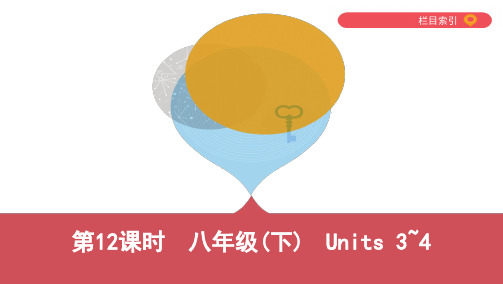
必备知识梳理 栏目索引
18. too much 太多 19. do one's part 尽某人的一份力 20. take care of/look after 照顾 21. as a result 结果 22. get into 从事;开始(某事) 23. look through 快速查看;浏览 24. be angry with 生气 25. big deal 重要的事 26. work out 成功地发展;解决
必备知识梳理 栏目索引
15.two(num.)→ second (序数词)第二 → secondly (adv.)第二;其次 16.clear(adj.)→ clearly (adv.)清楚地;清晰地;明白地 17.cloud(n.)→ cloudy (adj.)多云的 18.type(n.)→ typical (adj.)典型的 19.maybe(adv.)→ perhaps (同义词)可能,大概,也许 20.independent(adj.)→ independence (n.)独立 21.neighborhood(n.)→ neighbor (n.)邻居 22.save(v.)→ waste (反义词)浪费
词汇语境运用 栏目索引
8.I don't want to waste my time talking with her. It's like playing the lute to a cow. 9.China has ended its one-child policy and let families have two children instead . 10.In order to look after themselves better, teenagers should try to improve their living skills .
2020-2021年英语八年级英语下册阅读理解及答案经典
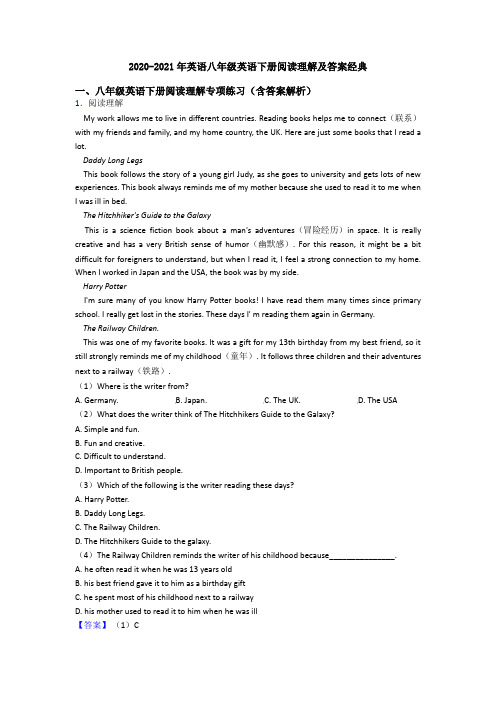
2020-2021年英语八年级英语下册阅读理解及答案经典一、八年级英语下册阅读理解专项练习(含答案解析)1.阅读理解My work allows me to live in different countries. Reading books helps me to connect(联系)with my friends and family, and my home country, the UK. Here are just some books that I read a lot.Daddy Long LegsThis book follows the story of a young girl Judy, as she goes to university and gets lots of new experiences. This book always reminds me of my mother because she used to read it to me when I was ill in bed.The Hitchhiker's Guide to the GalaxyThis is a science fiction book about a man's adventures(冒险经历)in space. It is really creative and has a very British sense of humor(幽默感). For this reason, it might be a bit difficult for foreigners to understand, but when I read it, I feel a strong connection to my home. When I worked in Japan and the USA, the book was by my side.Harry PotterI'm sure many of you know Harry Potter books! I have read them many times since primary school. I really get lost in the stories. These days I' m reading them again in Germany.The Railway Children.This was one of my favorite books. It was a gift for my 13th birthday from my best friend, so it still strongly reminds me of my childhood(童年). It follows three children and their adventures next to a railway(铁路).(1)Where is the writer from?A. Germany.B. Japan.C. The UK.D. The USA(2)What does the writer think of The Hitchhikers Guide to the Galaxy?A. Simple and fun.B. Fun and creative.C. Difficult to understand.D. Important to British people.(3)Which of the following is the writer reading these days?A. Harry Potter.B. Daddy Long Legs.C. The Railway Children.D. The Hitchhikers Guide to the galaxy.(4)The Railway Children reminds the writer of his childhood because_______________.A. he often read it when he was 13 years oldB. his best friend gave it to him as a birthday giftC. he spent most of his childhood next to a railwayD. his mother used to read it to him when he was ill【答案】(1)C(2)B(3)A(4)D【解析】【分析】这篇文章以表格的形式,向我们介绍了作者经常读《Daddy Long Legs》等三本书的原因。
人教版八年级下册英语第一单元阅读理解

人教版八年级下册英语第一单元阅读理解Unit 1 FriendshipPart One: Pre-readingBefore we dive into the reading comprehension exercises in this unit, let's take a moment to reflect on the importance of friendship in our lives. Friends play a significant role in our emotional well-being, providing support, companionship, and laughter in both good times and bad. In fact, studies have shown that having strong social connections can improve our physical health and overall happiness.Think about your own circle of friends. What qualities do you value in a friend? Is it loyalty, trustworthiness, a sense of humor, or a willingness to listen? Each of us may have a different answer, but one thing is clear: true friendships are built on mutual respect, communication, and shared experiences.Part Two: Reading ComprehensionNow, let's explore some stories and articles centered around the theme of friendship. As you read each passage, pay attention to the relationships between the characters, the challenges they face, and the ways in which they support each other.1. The BFF ChallengeIn this story, two best friends, Lily and Sarah, decide to take on a challenge together - running a marathon. Despite facing obstacles along the way, including injuries and doubts about their abilities, the girls support each other and ultimately cross the finish line hand in hand. This story highlights the power of friendship in overcoming adversity and achieving shared goals.2. The Science of FriendshipIn this informative article, we learn about the psychological and physiological benefits of friendships. Research shows that close friendships can reduce stress, enhance self-esteem, and even increase lifespan. By nurturing our relationships with friends, we not only improve our mental and emotionalwell-being but also boost our physical health.3. A Friend in NeedIn this heartwarming tale, a young boy named Jack befriends a new student at school who is struggling to fit in. Despite facing peer pressure to ignore the new student, Jack stands by his side and helps him navigate the social challenges of middle school. Through his kindness and empathy, Jack demonstrates the truemeaning of friendship - being there for someone when they need it most.Part Three: Discussion QuestionsAfter reading these passages, consider the following questions to deepen your understanding of friendship:1. How do the stories and articles in this unit illustrate the importance of communication in friendships?2. What qualities do you think are essential for maintaining a strong and lasting friendship?3. Have you ever faced a situation where a friend helped you through a difficult time? How did their support impact your life?4. In what ways can we be better friends to those around us, both in times of need and in times of joy?As you reflect on these questions, remember that friendships are a vital and enriching part of our lives. By nurturing and cherishing these relationships, we can create lasting bonds that bring joy, comfort, and support to our journey through life.Unit 1 Friendship – Reading Comprehension1. The BFF ChallengeLily and Sarah were inseparable best friends. They did everything together, from sharing secrets to dreaming about their future adventures. One day, Sarah came up with an idea that would change their lives forever - running a marathon.At first, Lily was hesitant. "I'm not sure I can do it," she admitted, looking down at her sneakers nervously. Sarah, with her trademark determination, replied, "We can do anything if we do it together. Let's take on this challenge as BFFs!"And so, the girls began their rigorous training regimen. They ran miles each day, pushing themselves to their limit and encouraging each other every step of the way. But as the race drew nearer, disaster struck - Lily sprained her ankle during a practice run."I'm sorry, Sarah," Lily said tearfully, afraid she would let her friend down. But Sarah simply smiled and replied, "We're in this together, remember? We'll find a way to make it work."On the day of the marathon, Lily and Sarah lined up at the starting line, their hearts pounding in unison. Together, they ran mile after mile, overcoming fatigue, doubts, and setbacks. And when they finally reached the finish line, they did it hand in hand, their smiles radiant with pride and accomplishment.2. The Science of FriendshipDid you know that having close friends can actually make you healthier? It's true! Studies have shown that strong social connections can boost our immune system, lower our risk of depression, and even help us live longer.When we spend time with friends, our bodies release hormones like oxytocin and endorphins, which reduce stress and increase feelings of happiness. In fact, laughing with friends has been shown to have a similar effect on our bodies as exercising!But it's not just our physical health that benefits from friendships. Emotional support from friends can help us navigate life's challenges, cope with stress, and build resilience in the face of adversity. By surrounding ourselves with positive and supportive people, we create a network of care and love that sustains us through life's ups and downs.So next time you're feeling down or stressed out, reach out to a friend. Whether it's a shoulder to cry on, a listening ear, or a good laugh, the power of friendship can work wonders for your mind, body, and soul.3. A Friend in NeedWhen a new student named Ben arrived at Jack's school, he immediately stood out from the crowd. Shy and awkward, with glasses that were too big for his face, Ben struggled to make friends and fit in with his classmates.Despite the whispers and stares from his peers, Jack felt a pang of empathy for Ben. He remembered what it was like to be the new kid in school, trying to find his place in an unfamiliar environment. So, he decided to reach out to Ben and offer him a friendly smile and a helping hand.As weeks passed, Jack and Ben became unlikely friends. They shared jokes, studied together, and even worked on a science project as partners. And when a group of bullies teased Ben during lunch one day, Jack stood up for his friend and told them to back off.From that day on, Ben was no longer alone. With Jack by his side, he found the courage to be himself, express his ideas, and make new friends. And Jack, in turn, discovered the true meaning of friendship - standing up for someone in need, no matter the cost.ConclusionFriendship is a precious gift that enriches our lives in countless ways. Through the stories and articles in this unit, we have explored the power of friendship to overcome challenges, improve our health, and bring joy to our hearts. May we all cherish and nurture the friendships in our lives, for they are the true treasures that light our way on this journey called life.。
初中英语阅读理解八年级(下) Units 1~2
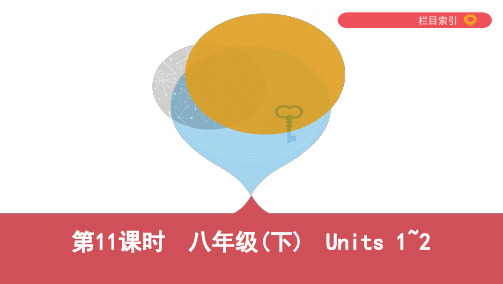
必备知识梳理 栏目索引
必备知识梳理
词汇拓展 1.foot(n.)→ feet (pl.)脚;足 → on foot 步行 2.knife(n.)→ knives (pl.)刀 3.interest(n.)→ interesting (adj.)有趣的 → interested (adj.)感兴趣的 → have an interested in/be interested in sth. 对某事感兴趣
必备知识梳理 栏目索引
必备知识梳理 栏目索引
—She should take her temperature. 5.—Should I put some medicine on it? —Yes, you should./No, you shouldn't. Unit 2 提供帮助 1.—Hi, Tom. I'm making some plans to work in an old people's home this summer. —Really?I did that last summer! 2.—...what did they ask you to help out with? —Mm...things like reading the newspaper to the old people...
必备知识梳理 栏目索引
→ imagine (doing) sth. 想象(做)某事 13.excite(v.)→ excited (adj.)激动的;兴奋的 → exciting (adj.)使人兴奋的;令人激动的 → be excited about 对……感到兴奋 14.train(v.)→ training (n.)训练;培训 → trainer (n.)教练员 15.lie(v.)→ lay (过去式) → lain (过去分词) → lying (现在分词)躺;平躺
八年级英语下册阅读理解知识点(大全)(word)1

八年级英语下册阅读理解知识点(大全)(word)1一、八年级英语下册阅读理解专项练习(含答案解析)1.阅读理解Imagine there is a bank that gives you $86,400 each morning. Every evening the bank deletes (删除) the part that you fail to use during the day. What would you do? Take out every cent,of course!Each of us has such a bank. Its name is TIME. Every morning, time gives you 86,400 seconds. Every day it opens a new account for you. Every night it burns the remains of the day. If you fail to use the day's savings, the lost is yours.To realize the value of ONE YEAR, ask a student who failed in SSC Exam.To realize the value of ONE MONTH, ask a mother who gave birth to a premature (早产的)baby.To realize the value of ONE WEEK, ask the editor of a weekly newspaper. To realize the value of ONE HOUR, ask the lovers who are waiting to meet. To realize the value of ONE MINUTE, ask a person who missed the train.To realize the value of ONE SECOND, ask a person who just avoided (避免) an accident.Make good use of every moment that you have. Remember that time waits for no one. Yesterday is history. Tomorrow is a mystery. Today is a gift. That's why it's called "The Present".(1)If you want to ask a person who just avoided an accident, you can realize the value of .A. one monthB. one weekC. one minuteD. one second(2)If you want to realize the value of ONE WEEK, .A. you can ask a student who failed in SSC ExamB. you can ask the editor of a weekly newspaperC. you can ask a person who missed the trainD. you can ask the lovers who are waiting to meet(3)In this passage, the writer tries to tell us .A. to value (珍视) friendshipB. to spend time with our familyC. to value our timeD. to know the difference of time units(单位)【答案】(1)D(2)B(3)C【解析】【分析】文章大意:文章通过银行做例子逐渐过渡到了时间,通过一年、一个月、一周、一个小时和一秒钟来论述时间的价值,告诉我们要珍惜时间。
最新英语八年级英语下册任务型阅读100及答案经典1
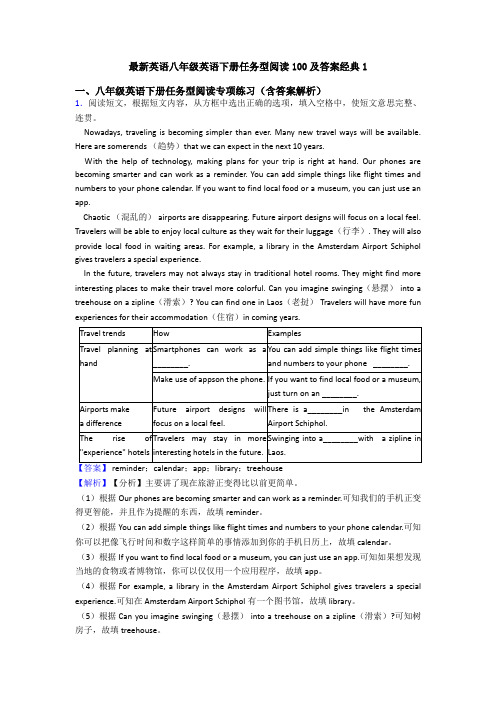
最新英语八年级英语下册任务型阅读100及答案经典1一、八年级英语下册任务型阅读专项练习(含答案解析)1.阅读短文,根据短文内容,从方框中选出正确的选项,填入空格中,使短文意思完整、连贯。
Nowadays, traveling is becoming simpler than ever. Many new travel ways will be available. Here are somerends (趋势)that we can expect in the next 10 years.With the help of technology, making plans for your trip is right at hand. Our phones are becoming smarter and can work as a reminder. You can add simple things like flight times and numbers to your phone calendar. If you want to find local food or a museum, you can just use an app.Chaotic (混乱的) airports are disappearing. Future airport designs will focus on a local feel. Travelers will be able to enjoy local culture as they wait for their luggage(行李). They will also provide local food in waiting areas. For example, a library in the Amsterdam Airport Schiphol gives travelers a special experience.In the future, travelers may not always stay in traditional hotel rooms. They might find more interesting places to make their travel more colorful. Can you imagine swinging(悬摆) into a treehouse on a zipline(滑索)? You can find one in Laos(老挝) Travelers will have more fun experiences for their accommodation(住宿)in coming years.【解析】【分析】主要讲了现在旅游正变得比以前更简单。
- 1、下载文档前请自行甄别文档内容的完整性,平台不提供额外的编辑、内容补充、找答案等附加服务。
- 2、"仅部分预览"的文档,不可在线预览部分如存在完整性等问题,可反馈申请退款(可完整预览的文档不适用该条件!)。
- 3、如文档侵犯您的权益,请联系客服反馈,我们会尽快为您处理(人工客服工作时间:9:00-18:30)。
八年级英语下册阅读理解知识点(大全)经典1一、八年级英语下册阅读理解专项练习(含答案解析)1.阅读理解Writing your own funny comic stripa. Practise drawing and create your characters.In order to ensure that you're at your very best, create sketches of basic items. People, animals, backgrounds, and props are excellent subjects to begin with.Choose attractive names for them and dip deep into your characters. This will help you connect to them, and you'll be able to bring them to life in your comics.b. Think of a short, amusing tale or a humorous skit featuring a joke for your comic.Once you establish a basic plot, write down the main story with additional details.c. Make a rough copy of your first comic.Determine its structure, as well as the size of the boxes that will contain the characters and their story. Use stick figures or quick drawings to figure out the basic skeleton of your comic. Do not worry about doing your best, as this is a rough draft.d. Create a unique name for your comic and a good copy of your comic.If you have trouble thinking of one, surf the Internet for suggestions or read other people's titles for inspiration.Once you are satisfied with the drawings, go over them with black ink for a professional look. To colour the comic, you can scan it into the computer and digitally colour it. Otherwise, you can use special colour pencils or markers.e. Show the comic to your family and friends and keep your comic in a safe place.Ask them to read it and give you a critique. This will help you to gauge how funny and successful your comic is, which will guide your future comic- making.Continue practising and creating new comics. You may consider publishing your works in the future.(1)What can you practise drawing by?A. People and animals.B. Backgrounds and props.C. People and forest.D. Both A and B.(2)What's the meaning of the underlined word in Para. 2?A. Funny.B. Surprised.C. Detailed.D. Lovely.(3)What's the correct order to write your own funny comic strip?①Think of a short, amus ing tale.②Create a good copy of your comic.③Create your characters.④Make a rough copy of your first comic.⑤Keep your comic in a safe place.A. ①-④-②-③-⑤B. ③-④-①-②-⑤C. ③-①-④-②-⑤ D. ③-①-④-⑤-②(4)How can you colour the comic?A. You can scan it without the computer and digitally colour it.B. You can use special colour pencils or markers.C. You can use common colour pencils or markers.D. You can use stick figures or quick drawings.【答案】(1)D(2)D(3)C(4)B【解析】【分析】本文主要讲述了如何写有趣的连环漫画。
(1)细节题。
根据a提到的 People, animals, backgrounds, and props are excellent subjects to begin with. 可知,练习画画可以通过人物,动物,背景和道具加以练习,故选D。
(2)推断题。
根据上下文可以推出,这个划线单词的意思是可爱的,故选D。
(3)细节题。
根据文中粗线条的字,依次排列,可知答案,故答案为C。
(4)细节题。
根据d提到的 Otherwise, you can use special colour pencils or markers,可知可以用特殊的颜色铅笔或水彩笔上色,故选B。
【点评】考查阅读理解。
本文涉及细节题、推断题和主旨题三种常考题型,细节题要注意从文中寻找答案;推断题需要联系上下文,推断出需要的信息;主旨题需要通读全文,了解大意之后找出中心思想。
2.阅读理解Every morning my father buys a newspaper on his way to work. Every evening my mother looks through magazines at home. And every night, I look at the posters with photos of David Beckham and Yao Ming on my bedroom wall before I go to sleep. Can we imagine life without paper or print?Paper was first created about 2,000 years ago, and has been made from silk, cotton, bamboo, and, since the 19th century, from wood. People learned to write words on paper to make a book. But in those days, books could only be produced one at a time by hand. As a result, they were expensive and rare. And because there weren't many books, few people learned to read.Then printing was invented in China. When printing was developed greatly at the beginning of the 11th century, books could be produced more quickly and cheaply. As a result, more people learned to read. After that, knowledge and ideas spread quickly.Today information can be received online, downloaded from the Internet rather than found in books, and information can be kept on CD-ROMs or machines such as MP3 players.Computers are already used in classrooms, and newspapers and magazines can already be read online. So will books be replaced by computers one day? No, I don't think the Yao Ming posters on my bedroom wall will ever be replaced by a two-metre-high computer!(1)What does the writer do before he goes to sleep?A. He reads books.B. He reads newspapers.C. He looks through magazines.D. He looks at the posters on the wall.(2)When was paper first created?A. About 2,000 years ago.B. In the 19th century.C. About 1,000 years ago.D. In the 11th century.(3)Why were books expensive and rare before the invention of printing?A. People could not read.B. People could not write words on paper.C. People could not find silk, cotton or bamboo.D. People could only produce books one at a time by hand.(4)What happened after books became cheaper? A. People didn't want to buy books. B. Printing was invented in China.C. Knowledge and ideas spread quickly.D. The Internet was introduced to people soon.【答案】 (1)D(2)A(3)D(4)C【解析】【分析】讲述了纸的起源,一开始的现状,讲述了纸和印刷术的发展过程。
